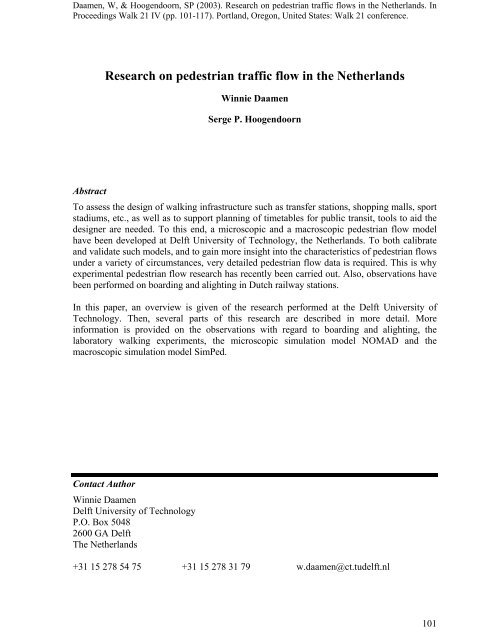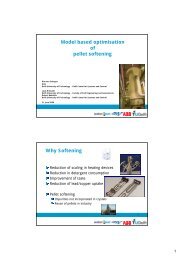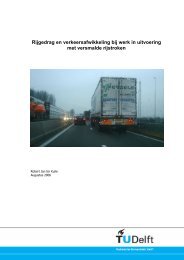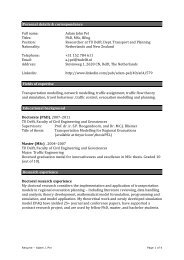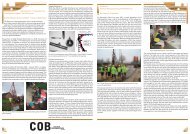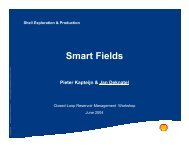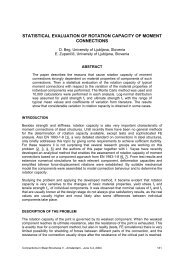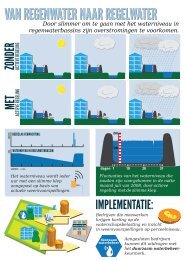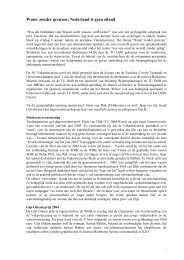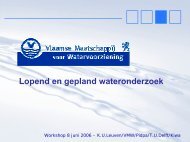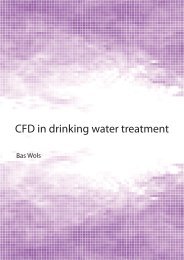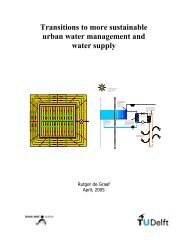Research on pedestrian traffic flow in the Netherlands - TU Delft
Research on pedestrian traffic flow in the Netherlands - TU Delft
Research on pedestrian traffic flow in the Netherlands - TU Delft
You also want an ePaper? Increase the reach of your titles
YUMPU automatically turns print PDFs into web optimized ePapers that Google loves.
Daamen, W, & Hoogendoorn, SP (2003). <str<strong>on</strong>g>Research</str<strong>on</strong>g> <strong>on</strong> <strong>pedestrian</strong> <strong>traffic</strong> <strong>flow</strong>s <strong>in</strong> <strong>the</strong> Ne<strong>the</strong>rlands. In<br />
Proceed<strong>in</strong>gs Walk 21 IV (pp. 101-117). Portland, Oreg<strong>on</strong>, United States: Walk 21 c<strong>on</strong>ference.<br />
<str<strong>on</strong>g>Research</str<strong>on</strong>g> <strong>on</strong> <strong>pedestrian</strong> <strong>traffic</strong> <strong>flow</strong> <strong>in</strong> <strong>the</strong> Ne<strong>the</strong>rlands<br />
W<strong>in</strong>nie Daamen<br />
Serge P. Hoogendoorn<br />
Abstract<br />
To assess <strong>the</strong> design of walk<strong>in</strong>g <strong>in</strong>frastructure such as transfer stati<strong>on</strong>s, shopp<strong>in</strong>g malls, sport<br />
stadiums, etc., as well as to support plann<strong>in</strong>g of timetables for public transit, tools to aid <strong>the</strong><br />
designer are needed. To this end, a microscopic and a macroscopic <strong>pedestrian</strong> <strong>flow</strong> model<br />
have been developed at <strong>Delft</strong> University of Technology, <strong>the</strong> Ne<strong>the</strong>rlands. To both calibrate<br />
and validate such models, and to ga<strong>in</strong> more <strong>in</strong>sight <strong>in</strong>to <strong>the</strong> characteristics of <strong>pedestrian</strong> <strong>flow</strong>s<br />
under a variety of circumstances, very detailed <strong>pedestrian</strong> <strong>flow</strong> data is required. This is why<br />
experimental <strong>pedestrian</strong> <strong>flow</strong> research has recently been carried out. Also, observati<strong>on</strong>s have<br />
been performed <strong>on</strong> board<strong>in</strong>g and alight<strong>in</strong>g <strong>in</strong> Dutch railway stati<strong>on</strong>s.<br />
In this paper, an overview is given of <strong>the</strong> research performed at <strong>the</strong> <strong>Delft</strong> University of<br />
Technology. Then, several parts of this research are described <strong>in</strong> more detail. More<br />
<strong>in</strong>formati<strong>on</strong> is provided <strong>on</strong> <strong>the</strong> observati<strong>on</strong>s with regard to board<strong>in</strong>g and alight<strong>in</strong>g, <strong>the</strong><br />
laboratory walk<strong>in</strong>g experiments, <strong>the</strong> microscopic simulati<strong>on</strong> model NOMAD and <strong>the</strong><br />
macroscopic simulati<strong>on</strong> model SimPed.<br />
C<strong>on</strong>tact Author<br />
W<strong>in</strong>nie Daamen<br />
<strong>Delft</strong> University of Technology<br />
P.O. Box 5048<br />
2600 GA <strong>Delft</strong><br />
The Ne<strong>the</strong>rlands<br />
+31 15 278 54 75 +31 15 278 31 79 w.daamen@ct.tudelft.nl<br />
101
Daamen, W, & Hoogendoorn, SP (2003). <str<strong>on</strong>g>Research</str<strong>on</strong>g> <strong>on</strong> <strong>pedestrian</strong> <strong>traffic</strong> <strong>flow</strong>s <strong>in</strong> <strong>the</strong> Ne<strong>the</strong>rlands. In<br />
Proceed<strong>in</strong>gs Walk 21 IV (pp. 101-117). Portland, Oreg<strong>on</strong>, United States: Walk 21 c<strong>on</strong>ference.<br />
W<strong>in</strong>nie Daamen<br />
<str<strong>on</strong>g>Research</str<strong>on</strong>g>er<br />
W<strong>in</strong>nie Daamen got her Masters degree <strong>in</strong> Civil Eng<strong>in</strong>eer<strong>in</strong>g <strong>on</strong> a simulati<strong>on</strong> model for<br />
<strong>pedestrian</strong>s <strong>in</strong> railway stati<strong>on</strong>. Dur<strong>in</strong>g her period as a PhD-student this model has been<br />
extended and developed fur<strong>the</strong>r <strong>in</strong>to <strong>the</strong> simulati<strong>on</strong> model SimPed. After hav<strong>in</strong>g worked<br />
several years as project manager for a railway c<strong>on</strong>sultancy, she is now a researcher at <strong>Delft</strong><br />
University of Technology <strong>in</strong> order to f<strong>in</strong>ish her PhD and to fur<strong>the</strong>r <strong>the</strong> scientific knowledge<br />
<strong>on</strong> <strong>pedestrian</strong> <strong>traffic</strong> <strong>flow</strong> and its impact <strong>on</strong> <strong>the</strong> design of transport facilities, as well as<br />
commercial centers.<br />
Serge P. Hoogendoorn<br />
Associate professor<br />
Serge Hoogendoorn is a senior lecturer <strong>in</strong> <strong>the</strong> research field of <strong>traffic</strong> <strong>flow</strong> <strong>the</strong>ory and<br />
model<strong>in</strong>g <strong>in</strong> general and <strong>in</strong> particular with respect to <strong>pedestrian</strong> <strong>flow</strong>. He received a pers<strong>on</strong>al<br />
grant from <strong>the</strong> Dutch <str<strong>on</strong>g>Research</str<strong>on</strong>g> Foundati<strong>on</strong> (NWO-MaGW) for <strong>the</strong> project ‘Walk<strong>in</strong>g behavior<br />
<strong>in</strong> public areas’. Toge<strong>the</strong>r with W<strong>in</strong>nie Daamen, he is <strong>in</strong>volved <strong>in</strong> experimental research,<br />
<strong>the</strong>ory development and model<strong>in</strong>g of <strong>pedestrian</strong> <strong>flow</strong>s.<br />
102
Daamen, W, & Hoogendoorn, SP (2003). <str<strong>on</strong>g>Research</str<strong>on</strong>g> <strong>on</strong> <strong>pedestrian</strong> <strong>traffic</strong> <strong>flow</strong>s <strong>in</strong> <strong>the</strong> Ne<strong>the</strong>rlands. In<br />
Proceed<strong>in</strong>gs Walk 21 IV (pp. 101-117). Portland, Oreg<strong>on</strong>, United States: Walk 21 c<strong>on</strong>ference.<br />
<str<strong>on</strong>g>Research</str<strong>on</strong>g> <strong>on</strong> <strong>pedestrian</strong> <strong>traffic</strong> <strong>flow</strong> <strong>in</strong> <strong>the</strong> Ne<strong>the</strong>rlands<br />
W<strong>in</strong>nie Daamen<br />
Serge P. Hoogendoorn<br />
Introducti<strong>on</strong><br />
Designers of walk<strong>in</strong>g <strong>in</strong>frastructure such as transfer stati<strong>on</strong>s, city center areas and shopp<strong>in</strong>g<br />
malls need to assess <strong>the</strong> quality of <strong>the</strong> plans. C<strong>on</strong>sequently, tools are needed, such as<br />
microscopic and macroscopic <strong>pedestrian</strong> <strong>flow</strong> models, as developed by <strong>the</strong> Transportati<strong>on</strong><br />
and Plann<strong>in</strong>g Secti<strong>on</strong> of <strong>the</strong> <strong>Delft</strong> University of Technology. Before <strong>the</strong> simulati<strong>on</strong> models<br />
can be applied <strong>in</strong> practice, <strong>the</strong>y must be calibrated and validated. In order to do this, as well<br />
as to ga<strong>in</strong> more <strong>in</strong>sight <strong>in</strong>to <strong>pedestrian</strong> behavior under different c<strong>on</strong>diti<strong>on</strong>s, very detailed<br />
empirical data are required. Also, <strong>the</strong>se data are used to fill exist<strong>in</strong>g gaps <strong>in</strong> knowledge <strong>on</strong><br />
<strong>pedestrian</strong> behavior. <strong>Delft</strong> University of Technology has recently carried out a number of<br />
<strong>pedestrian</strong> <strong>flow</strong> experiments. Fur<strong>the</strong>rmore, observati<strong>on</strong>s have been performed of <strong>the</strong> board<strong>in</strong>g<br />
and alight<strong>in</strong>g process <strong>in</strong> Dutch railway stati<strong>on</strong>s.<br />
Large-scale experimental research <strong>on</strong> <strong>pedestrian</strong> <strong>flow</strong>s has not been performed before. Not<br />
<strong>on</strong>ly <strong>pedestrian</strong> research <strong>in</strong> <strong>the</strong> form of experiments is an important <strong>in</strong>novati<strong>on</strong>, also <strong>the</strong> scale<br />
of <strong>the</strong> experiments and <strong>the</strong> amount of very detailed data <strong>on</strong> <strong>in</strong>dividual <strong>pedestrian</strong>s is unique.<br />
Not <strong>on</strong>ly <strong>the</strong> observati<strong>on</strong> technology has unique aspects; also <strong>the</strong> software specifically<br />
developed for automated track<strong>in</strong>g of <strong>pedestrian</strong>s did not exist. Fur<strong>the</strong>r <strong>in</strong>novati<strong>on</strong>s <strong>in</strong> <strong>the</strong>ory<br />
are <strong>the</strong> development of optimal c<strong>on</strong>trol models and <strong>the</strong> descripti<strong>on</strong> of <strong>pedestrian</strong> behavior <strong>in</strong><br />
bottlenecks. F<strong>in</strong>ally, two simulati<strong>on</strong> models for <strong>pedestrian</strong> <strong>flow</strong>s have been developed, to<br />
describe <strong>in</strong>dividual <strong>pedestrian</strong> behavior (NOMAD) and to describe <strong>pedestrian</strong> <strong>flow</strong>s <strong>in</strong><br />
transfer stati<strong>on</strong>s, <strong>in</strong>clud<strong>in</strong>g <strong>the</strong> <strong>in</strong>teracti<strong>on</strong> with public transport vehicles (SimPed).<br />
In this paper, first a short overview is given of <strong>the</strong> research performed at <strong>the</strong> <strong>Delft</strong> University<br />
of Technology. Then, we focus <strong>on</strong> several parts of this research. More detailed <strong>in</strong>formati<strong>on</strong> is<br />
given of observati<strong>on</strong>s of board<strong>in</strong>g and alight<strong>in</strong>g at Dutch railway stati<strong>on</strong>s, laboratory walk<strong>in</strong>g<br />
experiments, <strong>the</strong> microscopic simulati<strong>on</strong> model NOMAD and <strong>the</strong> macroscopic simulati<strong>on</strong><br />
model SimPed.<br />
Overview of <strong>the</strong> research performed at <strong>the</strong> <strong>Delft</strong> University of Technology<br />
In general <strong>the</strong> research lifecycle of physical, psychological, or biological phenomena<br />
<strong>in</strong>volves <strong>the</strong> follow<strong>in</strong>g stages:<br />
• Empiricism<br />
• Theory<br />
• Models<br />
103
Daamen, W, & Hoogendoorn, SP (2003). <str<strong>on</strong>g>Research</str<strong>on</strong>g> <strong>on</strong> <strong>pedestrian</strong> <strong>traffic</strong> <strong>flow</strong>s <strong>in</strong> <strong>the</strong> Ne<strong>the</strong>rlands. In<br />
Proceed<strong>in</strong>gs Walk 21 IV (pp. 101-117). Portland, Oreg<strong>on</strong>, United States: Walk 21 c<strong>on</strong>ference.<br />
Empiricism or observati<strong>on</strong>s is used to view <strong>the</strong> actual processes and form a basis for <strong>the</strong><br />
development of general <strong>the</strong>ories. Models are at <strong>the</strong>ir turn based <strong>on</strong> <strong>the</strong>se <strong>the</strong>ories. Potentially<br />
powerful <strong>in</strong>struments to be used by designers and planners of <strong>the</strong> walk<strong>in</strong>g envir<strong>on</strong>ment are<br />
simulati<strong>on</strong> models, given that <strong>the</strong>se models are adequately calibrated and validated. In <strong>the</strong><br />
follow<strong>in</strong>g secti<strong>on</strong>s, for each of <strong>the</strong> topics an overview is given of <strong>the</strong> research performed by<br />
<strong>Delft</strong> University of Technology, Transportati<strong>on</strong> and Plann<strong>in</strong>g Secti<strong>on</strong>.<br />
Empiricism<br />
Two empirical studies have been performed <strong>in</strong> 2000, 2001 and 2002. The first study<br />
c<strong>on</strong>sisted of large-scale laboratory experiments <strong>on</strong> walk<strong>in</strong>g behavior. Pedestrians, a sample<br />
representative for <strong>the</strong> Dutch populati<strong>on</strong>, were <strong>in</strong>vited to participate <strong>in</strong> <strong>the</strong>se experiments. At<br />
May 16, ten experiments were performed <strong>in</strong> two waves, with about 80 participants per wave.<br />
The aim of <strong>the</strong>se experiments was to observe <strong>pedestrian</strong> walk<strong>in</strong>g behavior <strong>in</strong> standard, stati<strong>on</strong><br />
and shopp<strong>in</strong>g c<strong>on</strong>diti<strong>on</strong>s. Also, <strong>pedestrian</strong> <strong>flow</strong>s <strong>in</strong> several directi<strong>on</strong>s and <strong>in</strong> bottlenecks are<br />
recorded <strong>on</strong> video.<br />
The goals of <strong>the</strong> sec<strong>on</strong>d empirical project are to quantify board<strong>in</strong>g and alight<strong>in</strong>g times and to<br />
ga<strong>the</strong>r basic data for a more accurate plann<strong>in</strong>g of <strong>the</strong> dwell times <strong>in</strong> public transport and an<br />
improved service operati<strong>on</strong>. The project is part of a research program <strong>in</strong>to <strong>the</strong> quality of tra<strong>in</strong><br />
service operati<strong>on</strong> and aim<strong>in</strong>g to develop <strong>in</strong>struments to improve <strong>the</strong> operati<strong>on</strong>al c<strong>on</strong>trol. A<br />
measurement project was carried out <strong>on</strong> a number of typical Dutch railway stati<strong>on</strong>s.<br />
Observed were: type of stati<strong>on</strong>, locati<strong>on</strong> of <strong>the</strong> platform accesses, type of tra<strong>in</strong> service, type<br />
of roll<strong>in</strong>g stock, tra<strong>in</strong> door widths, number of board<strong>in</strong>g and alight<strong>in</strong>g passengers, period of<br />
day and durati<strong>on</strong> of <strong>the</strong> dwell period, split up <strong>in</strong> alight<strong>in</strong>g, board<strong>in</strong>g and wait<strong>in</strong>g for<br />
departure.<br />
Fur<strong>the</strong>rmore, two smaller studies have been performed <strong>on</strong> observati<strong>on</strong>al techniques. The first<br />
study c<strong>on</strong>centrated <strong>on</strong> <strong>pedestrian</strong> route choice, especially <strong>on</strong> <strong>the</strong> choice between stairs and<br />
escalators <strong>in</strong> metro stati<strong>on</strong>s. Observati<strong>on</strong>s have been made <strong>on</strong> several locati<strong>on</strong>s, result<strong>in</strong>g <strong>in</strong><br />
<strong>in</strong>sight <strong>in</strong>to aspects affect<strong>in</strong>g this part of <strong>the</strong> route choice.<br />
The aim of <strong>the</strong> sec<strong>on</strong>d study was to determ<strong>in</strong>e distributi<strong>on</strong>s for wait<strong>in</strong>g and service times for<br />
ticket<strong>in</strong>g. Two ways of obta<strong>in</strong><strong>in</strong>g a ticket are available for <strong>the</strong> passenger: he or she can buy<br />
his ticket offices or at ticket mach<strong>in</strong>es. Pedestrian aspects <strong>in</strong>volv<strong>in</strong>g <strong>the</strong> choice for ei<strong>the</strong>r a<br />
ticket mach<strong>in</strong>e or a ticket office were recorded and distributi<strong>on</strong>s were derived to estimate<br />
wait<strong>in</strong>g and service times, depend<strong>in</strong>g <strong>on</strong> <strong>pedestrian</strong> characteristics.<br />
Ongo<strong>in</strong>g research <strong>in</strong>volves <strong>pedestrian</strong> route choice, especially <strong>in</strong> transfer stati<strong>on</strong>s. The aim of<br />
this project is to develop a <strong>pedestrian</strong> route choice model, predict<strong>in</strong>g routes based <strong>on</strong><br />
<strong>pedestrian</strong> and route characteristics. In order to calibrate and validate this model,<br />
observati<strong>on</strong>s are performed at Dutch railway stati<strong>on</strong>s <strong>in</strong> <strong>the</strong> m<strong>on</strong>ths of April and May 2003.<br />
Theory<br />
Based <strong>on</strong> <strong>the</strong> observati<strong>on</strong>s described <strong>in</strong> <strong>the</strong> previous secti<strong>on</strong>, exist<strong>in</strong>g <strong>the</strong>ories are extended<br />
and new <strong>the</strong>ories are developed. Theories <strong>on</strong> <strong>pedestrian</strong> <strong>traffic</strong> <strong>flow</strong> refer to several fields:<br />
104
Daamen, W, & Hoogendoorn, SP (2003). <str<strong>on</strong>g>Research</str<strong>on</strong>g> <strong>on</strong> <strong>pedestrian</strong> <strong>traffic</strong> <strong>flow</strong>s <strong>in</strong> <strong>the</strong> Ne<strong>the</strong>rlands. In<br />
Proceed<strong>in</strong>gs Walk 21 IV (pp. 101-117). Portland, Oreg<strong>on</strong>, United States: Walk 21 c<strong>on</strong>ference.<br />
• Walk<strong>in</strong>g behavior<br />
o General applicable under various circumstances<br />
o Specifically for transfer stati<strong>on</strong>s<br />
• Route choice<br />
• Board<strong>in</strong>g and alight<strong>in</strong>g, or <strong>the</strong> <strong>in</strong>teracti<strong>on</strong> between public transport vehicles and<br />
walk<strong>in</strong>g as an access or egress mode<br />
• Activity behavior<br />
o Decisi<strong>on</strong> mak<strong>in</strong>g (activity choice, locati<strong>on</strong> choice)<br />
o Wait<strong>in</strong>g<br />
o Be<strong>in</strong>g served<br />
Most of <strong>the</strong> <strong>the</strong>oretical research is based <strong>on</strong> observati<strong>on</strong>s and functi<strong>on</strong> as basis for <strong>the</strong><br />
development of simulati<strong>on</strong> models. Some of <strong>the</strong>se general <strong>in</strong>novative approaches are not<br />
restricted to <strong>pedestrian</strong> <strong>flow</strong>s, especially experimental design issues, observati<strong>on</strong> techniques<br />
and model<strong>in</strong>g approaches.<br />
Simulati<strong>on</strong> models<br />
Two simulati<strong>on</strong> models have been developed: NOMAD and SimPed. NOMAD models<br />
<strong>in</strong>dividual <strong>pedestrian</strong>s. NOMAD c<strong>on</strong>sists of two mutually dependent models. The top-level<br />
model jo<strong>in</strong>tly predicts <strong>pedestrian</strong> activity schedul<strong>in</strong>g, activity area choice, and route choice <strong>in</strong><br />
public spaces. A ma<strong>in</strong> <strong>in</strong>novati<strong>on</strong> is that routes may be c<strong>on</strong>t<strong>in</strong>uous curves <strong>in</strong> space and time,<br />
ra<strong>the</strong>r than an ordered set of l<strong>in</strong>ks. Moreover, <strong>pedestrian</strong>s can choose between multiple<br />
activity areas where to perform <strong>the</strong>ir activities. The preferred locati<strong>on</strong> will be <strong>in</strong>fluenced by<br />
<strong>the</strong> route choice, and vice versa. The down-level model describes <strong>the</strong> walk<strong>in</strong>g behavior. The<br />
microscopic model is based <strong>on</strong> <strong>the</strong> behavioral assumpti<strong>on</strong> that optimal predictive feedback<br />
c<strong>on</strong>trollers with limited predicti<strong>on</strong> horiz<strong>on</strong> can describe <strong>pedestrian</strong>s adequately.<br />
SimPed is a simulati<strong>on</strong> model for <strong>pedestrian</strong> <strong>flow</strong>s, developed <strong>in</strong> co-operati<strong>on</strong> with Holland<br />
Railc<strong>on</strong>sult, a Dutch c<strong>on</strong>sult<strong>in</strong>g eng<strong>in</strong>eer<strong>in</strong>g firm for public transport and railway<br />
<strong>in</strong>frastructure. The aim of SimPed is to estimate both mean and variability of walk<strong>in</strong>g times<br />
<strong>in</strong>curred by transferr<strong>in</strong>g passengers and to visualize walk<strong>in</strong>g patterns <strong>in</strong>side transfer stati<strong>on</strong>s<br />
and o<strong>the</strong>r <strong>pedestrian</strong> areas. Simulati<strong>on</strong> studies with this tool quantify <strong>the</strong> effects of stati<strong>on</strong><br />
layouts <strong>on</strong> <strong>pedestrian</strong>s <strong>in</strong> a transfer stati<strong>on</strong>. Moreover, SimPed is used to analyze effects of<br />
timetables of <strong>the</strong> various public transport systems (departure and arrival times, type of roll<strong>in</strong>g<br />
stock) <strong>on</strong> passenger <strong>flow</strong>s <strong>in</strong> and through <strong>the</strong> transfer stati<strong>on</strong> (c<strong>on</strong>gesti<strong>on</strong>, transfer times).<br />
Board<strong>in</strong>g and alight<strong>in</strong>g <strong>in</strong> railway stati<strong>on</strong>s<br />
The durati<strong>on</strong> of dwell times at stati<strong>on</strong>s is determ<strong>in</strong>ed by <strong>the</strong> scheduled dwell times, <strong>the</strong><br />
number of alight<strong>in</strong>g and board<strong>in</strong>g passengers, tra<strong>in</strong> and <strong>in</strong>frastructural characteristics, and <strong>the</strong><br />
arrival and departure process of <strong>the</strong> tra<strong>in</strong>s (Wiggenraad (2002)).<br />
Parameters determ<strong>in</strong>ed are <strong>the</strong> dwell time and its comp<strong>on</strong>ents (board<strong>in</strong>g, alight<strong>in</strong>g, wait<strong>in</strong>g,<br />
etc.), <strong>the</strong> distributi<strong>on</strong> of <strong>the</strong> passengers over <strong>the</strong> platform, and <strong>the</strong> <strong>in</strong>fluence of type of stati<strong>on</strong>,<br />
<strong>the</strong> type of tra<strong>in</strong> service, vehicle characteristics (door passageway width) and period of day<br />
(peak and off-peak).<br />
105
Daamen, W, & Hoogendoorn, SP (2003). <str<strong>on</strong>g>Research</str<strong>on</strong>g> <strong>on</strong> <strong>pedestrian</strong> <strong>traffic</strong> <strong>flow</strong>s <strong>in</strong> <strong>the</strong> Ne<strong>the</strong>rlands. In<br />
Proceed<strong>in</strong>gs Walk 21 IV (pp. 101-117). Portland, Oreg<strong>on</strong>, United States: Walk 21 c<strong>on</strong>ference.<br />
In October 2000 and May 2002 measurements were carried out <strong>on</strong> eleven typical Dutch<br />
railway stati<strong>on</strong>s, be<strong>in</strong>g five local stati<strong>on</strong>s and five <strong>in</strong>tercity stati<strong>on</strong>s with different locati<strong>on</strong>s of<br />
<strong>the</strong> platform accesses. Also, measurements were carried out <strong>in</strong> a metro stati<strong>on</strong>. One observer<br />
recorded with a stopwatch <strong>the</strong> tra<strong>in</strong> movements and each of a number of observers was<br />
allocated to a platform sector and recorded with a digitiser <strong>the</strong> number of wait<strong>in</strong>g passengers<br />
and <strong>the</strong> moments of passenger movements (alight<strong>in</strong>g or board<strong>in</strong>g).<br />
boards<br />
alights<br />
door opens<br />
door closes<br />
enter a<br />
number<br />
Figure 1. Digitiser used for observati<strong>on</strong>s <strong>in</strong> Dutch railway stati<strong>on</strong>s<br />
The measured dwell times, especially for <strong>in</strong>tercity tra<strong>in</strong>s, <strong>in</strong> general exceeded <strong>the</strong> scheduled<br />
<strong>on</strong>es. In <strong>the</strong> timetable local tra<strong>in</strong>s are scheduled to dwell 60 sec<strong>on</strong>ds. In practice <strong>the</strong> dwell<br />
time varies from 90 to 120 sec<strong>on</strong>ds. On <strong>the</strong> average, tra<strong>in</strong>s arrive generally late at stati<strong>on</strong>s<br />
(<strong>in</strong>tercity tra<strong>in</strong>s about 210 sec<strong>on</strong>ds). Added with <strong>the</strong> dwell times l<strong>on</strong>ger than scheduled, tra<strong>in</strong>s<br />
depart with even l<strong>on</strong>ger delays (<strong>in</strong>tercity tra<strong>in</strong>s about 280 sec<strong>on</strong>ds).<br />
Dwell times <strong>in</strong> peak and off-peak hours are about equal. In peak hours <strong>the</strong> length of alight<strong>in</strong>g<br />
and board<strong>in</strong>g time <strong>in</strong> clusters is l<strong>on</strong>ger due to <strong>the</strong> larger numbers of passengers, but this is<br />
compensated by <strong>the</strong> shorter rema<strong>in</strong><strong>in</strong>g alight<strong>in</strong>g and board<strong>in</strong>g time of <strong>in</strong>dividual passengers.<br />
The percentage of <strong>the</strong> wasted time and <strong>the</strong> dispatch<strong>in</strong>g time <strong>in</strong> general is c<strong>on</strong>stant, up to 20%.<br />
There are clear c<strong>on</strong>centrati<strong>on</strong>s of wait<strong>in</strong>g and board<strong>in</strong>g passengers around platform accesses.<br />
Stairs at <strong>the</strong> end of <strong>the</strong> platform lead to higher c<strong>on</strong>centrati<strong>on</strong>s than locati<strong>on</strong>s <strong>in</strong> <strong>the</strong> middle or<br />
<strong>on</strong> <strong>on</strong>e third and two thirds of <strong>the</strong> platform.<br />
The mean alight<strong>in</strong>g and board<strong>in</strong>g time per passenger <strong>in</strong> clusters is about 1 sec<strong>on</strong>d. A clear<br />
difference exists <strong>in</strong> time length between types of roll<strong>in</strong>g stock, i.e. dependent <strong>on</strong> <strong>the</strong> width of<br />
<strong>the</strong> passageway. Wide door double-decker tra<strong>in</strong>s have 10% shorter time values and <strong>in</strong>tercity<br />
roll<strong>in</strong>g stock with narrow door width results <strong>in</strong> about 10% l<strong>on</strong>ger time values than this<br />
average. Surpris<strong>in</strong>gly, <strong>the</strong>re is no difference found <strong>in</strong> alight<strong>in</strong>g and board<strong>in</strong>g times per<br />
passenger <strong>in</strong> clusters between peak and off-peak hours.<br />
106
Daamen, W, & Hoogendoorn, SP (2003). <str<strong>on</strong>g>Research</str<strong>on</strong>g> <strong>on</strong> <strong>pedestrian</strong> <strong>traffic</strong> <strong>flow</strong>s <strong>in</strong> <strong>the</strong> Ne<strong>the</strong>rlands. In<br />
Proceed<strong>in</strong>gs Walk 21 IV (pp. 101-117). Portland, Oreg<strong>on</strong>, United States: Walk 21 c<strong>on</strong>ference.<br />
Laboratory experiments<br />
<strong>Delft</strong> University of Technology has recently collected data by carry<strong>in</strong>g out experimental<br />
<strong>pedestrian</strong> <strong>flow</strong> research.<br />
Experimental set up<br />
In <strong>the</strong> walk<strong>in</strong>g experiments, two types of variables have been dist<strong>in</strong>guished: ‘experimental<br />
variables’ and ‘c<strong>on</strong>text variables’. Experimental variables are <strong>in</strong>fluenced dur<strong>in</strong>g <strong>the</strong> various<br />
experiments, while c<strong>on</strong>text variables are specific for each <strong>pedestrian</strong>. The follow<strong>in</strong>g<br />
experimental variables are c<strong>on</strong>sidered:<br />
• Free speed<br />
• Walk<strong>in</strong>g directi<strong>on</strong><br />
• Density<br />
• Bottlenecks<br />
These variables are varied <strong>in</strong> <strong>the</strong> experiments as follows:<br />
Free speed<br />
A. Normal (100% of <strong>the</strong> <strong>pedestrian</strong>s ma<strong>in</strong>ta<strong>in</strong>s its own free speed)<br />
B. Stati<strong>on</strong> c<strong>on</strong>diti<strong>on</strong>s (60% normal speed, 40% higher speed)<br />
C. Shopp<strong>in</strong>g c<strong>on</strong>diti<strong>on</strong>s (60% normal speed, 40% lower speed)<br />
Walk<strong>in</strong>g directi<strong>on</strong><br />
The various directi<strong>on</strong>s are abbreviated: we = from west to east, ew = from east to west, ns =<br />
from north to south and sn = from south to north.<br />
A. One directi<strong>on</strong> (100% we)<br />
B. Equal <strong>flow</strong>s <strong>in</strong> two directi<strong>on</strong>s (50% we, 50% ew)<br />
C. One small opposite <strong>flow</strong> (90% we, 10% ew)<br />
D. Two equal cross<strong>in</strong>g <strong>flow</strong>s (50% we, 50% sn)<br />
E. One small cross<strong>in</strong>g <strong>flow</strong> (90% we, 10% sn)<br />
F. Four equal cross<strong>in</strong>g <strong>flow</strong>s (25% we, 25% ew, 25% ns, 25% sn)<br />
Bottlenecks<br />
A. No bottlenecks<br />
B. Bottleneck with a width of 2 meters<br />
C. Bottleneck with a width of 1 meter<br />
Density<br />
The density varies between an almost empty and an almost completely occupied area. Dur<strong>in</strong>g<br />
<strong>the</strong> experiment extra groups are admitted to <strong>the</strong> observati<strong>on</strong> area. The density is thus<br />
<strong>in</strong>creased <strong>in</strong> a stepwise manner, until all groups participate. The size of <strong>the</strong> area is chosen<br />
such that c<strong>on</strong>gesti<strong>on</strong> is possible.<br />
Compared to <strong>the</strong> reference variant (<strong>on</strong>e directi<strong>on</strong>al <strong>flow</strong> with normal free speeds without<br />
bottlenecks (experiment 1) <strong>on</strong>e variable is varied per experiment. This leads to 10<br />
experiments (see Figure 2):<br />
107
Daamen, W, & Hoogendoorn, SP (2003). <str<strong>on</strong>g>Research</str<strong>on</strong>g> <strong>on</strong> <strong>pedestrian</strong> <strong>traffic</strong> <strong>flow</strong>s <strong>in</strong> <strong>the</strong> Ne<strong>the</strong>rlands. In<br />
Proceed<strong>in</strong>gs Walk 21 IV (pp. 101-117). Portland, Oreg<strong>on</strong>, United States: Walk 21 c<strong>on</strong>ference.<br />
Table 1. Overview of <strong>the</strong> ten experiments<br />
Free speed Walk<strong>in</strong>g directi<strong>on</strong> Bottlenecks<br />
A B C A B C D E F A B C<br />
1 (ref) x x x<br />
2 x x x<br />
3 x x x<br />
4 x x x<br />
5 x x x<br />
6 x x x<br />
7 x x x<br />
8 x x x<br />
9 x x x<br />
10 x x x<br />
Experiment 1<br />
62.5% normal speed<br />
37.5% high speed<br />
Experiment 2<br />
62.5% normal speed<br />
37.5% low speed<br />
Experiment 3<br />
50%<br />
50%<br />
87.5%<br />
12.5%<br />
Experiment 4<br />
Experiment 5<br />
25%<br />
50%<br />
87.5%<br />
25%<br />
25%<br />
50%<br />
Experiment 6<br />
12.5%<br />
Experiment 7<br />
25%<br />
Experiment 8<br />
Experiment 9 Experiment 10<br />
Figure 2. Overview of <strong>the</strong> ten experiments<br />
108
Daamen, W, & Hoogendoorn, SP (2003). <str<strong>on</strong>g>Research</str<strong>on</strong>g> <strong>on</strong> <strong>pedestrian</strong> <strong>traffic</strong> <strong>flow</strong>s <strong>in</strong> <strong>the</strong> Ne<strong>the</strong>rlands. In<br />
Proceed<strong>in</strong>gs Walk 21 IV (pp. 101-117). Portland, Oreg<strong>on</strong>, United States: Walk 21 c<strong>on</strong>ference.<br />
The experiments can fur<strong>the</strong>r be classified <strong>in</strong> four categories:<br />
• One directi<strong>on</strong>al <strong>traffic</strong><br />
o Experiment 1: reference c<strong>on</strong>diti<strong>on</strong>s<br />
o Experiment 2: stati<strong>on</strong> c<strong>on</strong>diti<strong>on</strong>s<br />
o Experiment 3: shopp<strong>in</strong>g c<strong>on</strong>diti<strong>on</strong>s<br />
• Two-directi<strong>on</strong>al <strong>traffic</strong><br />
o Experiment 4: two equal opposite <strong>flow</strong>s (walkway)<br />
o Experiment 5: <strong>on</strong>e small opposite <strong>flow</strong> (late passengers head<strong>in</strong>g for <strong>the</strong><br />
already arrived tra<strong>in</strong>, while most passengers already got out)<br />
• Cross<strong>in</strong>g <strong>traffic</strong><br />
o Experiment 6: two equal cross<strong>in</strong>g <strong>flow</strong>s<br />
o Experiment 7: <strong>on</strong>e small cross<strong>in</strong>g <strong>flow</strong><br />
o Experiment 8: four equal cross<strong>in</strong>g <strong>flow</strong>s (a stati<strong>on</strong> hall)<br />
• Bottlenecks<br />
o Experiment 9: wide bottleneck (walk from a hall <strong>in</strong>to a small walkway)<br />
o Experiment 10: small bottleneck (wide walkway suddenly narrowed)<br />
Carry<strong>in</strong>g out <strong>the</strong> experiments<br />
Measurement set up<br />
Two observati<strong>on</strong> areas are used. For <strong>the</strong> <strong>on</strong>e and two-directi<strong>on</strong>al experiments and <strong>the</strong><br />
experiments with a bottleneck a rectangular area is taken of 10 meters l<strong>on</strong>g and 4 meters<br />
wide. For <strong>the</strong> cross<strong>in</strong>g <strong>flow</strong> experiments a square observati<strong>on</strong> area is used with a side of 8<br />
meters. The images <strong>in</strong> Figure 3 give an impressi<strong>on</strong> of <strong>the</strong> experiments.<br />
Figure 3. Impressi<strong>on</strong> of <strong>the</strong> experiments<br />
The experiments have taken place <strong>in</strong> a large hallway <strong>in</strong> <strong>the</strong> Civil Eng<strong>in</strong>eer<strong>in</strong>g build<strong>in</strong>g of<br />
<strong>Delft</strong> University of Technology, and have been measured us<strong>in</strong>g a digital video camera, fixed<br />
at <strong>the</strong> ceil<strong>in</strong>g at a height of 10 meters (for details see Daamen and Hoogendoorn (2003) and<br />
Hoogendoorn and Daamen (2003)).<br />
109
Daamen, W, & Hoogendoorn, SP (2003). <str<strong>on</strong>g>Research</str<strong>on</strong>g> <strong>on</strong> <strong>pedestrian</strong> <strong>traffic</strong> <strong>flow</strong>s <strong>in</strong> <strong>the</strong> Ne<strong>the</strong>rlands. In<br />
Proceed<strong>in</strong>gs Walk 21 IV (pp. 101-117). Portland, Oreg<strong>on</strong>, United States: Walk 21 c<strong>on</strong>ference.<br />
Experimental subjects<br />
Participants were recruited by advertis<strong>in</strong>g <strong>in</strong> local newspapers, <strong>the</strong> university newspaper and<br />
newsletters. Also an Internet site has been developed. This resulted <strong>in</strong> 140 registrati<strong>on</strong>s; <strong>the</strong><br />
sample appeared representative for actual practice.<br />
Realizati<strong>on</strong><br />
Each participant wore a white t-shirt and a cap (red or green) to facilitate automatic<br />
process<strong>in</strong>g of <strong>the</strong> video images. The participants have been divided <strong>in</strong>to groups, which<br />
received a specific walk<strong>in</strong>g order <strong>in</strong> each experiment. The color of <strong>the</strong> caps made <strong>the</strong> groups<br />
dist<strong>in</strong>guishable.<br />
A <strong>traffic</strong> light <strong>in</strong>dicated when a <strong>pedestrian</strong> could enter <strong>the</strong> area <strong>in</strong> order to divide <strong>the</strong><br />
<strong>pedestrian</strong>s equally over <strong>the</strong> area and to prevent that already <strong>in</strong> <strong>the</strong> beg<strong>in</strong>n<strong>in</strong>g of <strong>the</strong><br />
experiment clusters are formed. The <strong>pedestrian</strong>s walked <strong>the</strong>n <strong>in</strong> <strong>the</strong> <strong>in</strong>dicated directi<strong>on</strong> over<br />
<strong>the</strong> area, while behav<strong>in</strong>g as normal as possible. After leav<strong>in</strong>g <strong>the</strong> area <strong>the</strong> <strong>pedestrian</strong>s walked<br />
around <strong>the</strong> area back to <strong>the</strong> start<strong>in</strong>g po<strong>in</strong>t. The process was <strong>the</strong>n stabilized dur<strong>in</strong>g a m<strong>in</strong>ute,<br />
after which <strong>the</strong> next group was admitted to <strong>the</strong> observati<strong>on</strong> area. This c<strong>on</strong>t<strong>in</strong>ued until all<br />
groups participated <strong>in</strong> <strong>the</strong> experiment, after which a l<strong>on</strong>ger stabilizati<strong>on</strong> period was applied.<br />
Then, <strong>the</strong> groups left <strong>the</strong> area <strong>on</strong>e by <strong>on</strong>e.<br />
Microscopic simulati<strong>on</strong> model NOMAD<br />
NOMAD (Hoogendoorn (2003)) dist<strong>in</strong>guishes different levels of <strong>pedestrian</strong> behavior:<br />
• Activity area and route choice level (tactical level)<br />
• Walk<strong>in</strong>g behavior (operati<strong>on</strong>al level)<br />
NOMAD is activity based, imply<strong>in</strong>g that <strong>the</strong> acti<strong>on</strong>s of <strong>the</strong> <strong>pedestrian</strong>s are largely determ<strong>in</strong>ed<br />
by <strong>the</strong> different activities <strong>pedestrian</strong>s have planned to perform while be<strong>in</strong>g <strong>in</strong> <strong>the</strong> walk<strong>in</strong>g<br />
facility. Given an activity pattern (ordered set of activities; e.g. buy<strong>in</strong>g a tra<strong>in</strong> ticket and<br />
subsequently gett<strong>in</strong>g to <strong>the</strong> tra<strong>in</strong> platform), and given <strong>the</strong> (multiple) areas where <strong>the</strong>se<br />
activities can be performed (ticket counters, tra<strong>in</strong> platforms), NOMAD determ<strong>in</strong>es <strong>the</strong> most<br />
likely areas where activities are performed, and <strong>the</strong> most likely routes between <strong>the</strong>m.<br />
NOMAD allows for completely free route choice: <strong>pedestrian</strong>s do not walk al<strong>on</strong>g l<strong>in</strong>ear,<br />
predeterm<strong>in</strong>ed paths; ra<strong>the</strong>r, <strong>the</strong> routes are c<strong>on</strong>t<strong>in</strong>uous paths <strong>in</strong> <strong>the</strong> c<strong>on</strong>t<strong>in</strong>uous space.<br />
Fur<strong>the</strong>rmore, <strong>the</strong> route choice and <strong>the</strong> activity area choice depends <strong>on</strong> <strong>the</strong> prevail<strong>in</strong>g <strong>traffic</strong><br />
c<strong>on</strong>diti<strong>on</strong>s, mean<strong>in</strong>g that when routes become c<strong>on</strong>gested, <strong>pedestrian</strong> avoid <strong>the</strong>se routes<br />
provided that <strong>the</strong>re are good route alternative available. F<strong>in</strong>ally, it is possible to def<strong>in</strong>e<br />
preferred walk<strong>in</strong>g areas (e.g. next to shopp<strong>in</strong>g w<strong>in</strong>dows, well-illum<strong>in</strong>ated areas, etc.), as well<br />
as to <strong>in</strong>clude specific k<strong>in</strong>ds of walk<strong>in</strong>g <strong>in</strong>frastructure, such as escalators, and stairs. While<br />
walk<strong>in</strong>g, <strong>pedestrian</strong>s aim to adhere to <strong>the</strong> shortest route. However, due to encounters with<br />
o<strong>the</strong>r <strong>pedestrian</strong>s, <strong>the</strong>y will generally not be able to do so. This holds equally for <strong>the</strong><br />
<strong>in</strong>teracti<strong>on</strong> with obstacles and walls. If a <strong>pedestrian</strong> drifts away from <strong>the</strong> shortest route, <strong>the</strong><br />
shortest route from that po<strong>in</strong>t <strong>on</strong>wards is used.<br />
The model<strong>in</strong>g of <strong>the</strong> operati<strong>on</strong>al walk<strong>in</strong>g task (e.g. accelerati<strong>on</strong> and <strong>in</strong>teracti<strong>on</strong> processes) is<br />
based <strong>on</strong> known empirical facts and <strong>the</strong>ory <strong>on</strong> <strong>pedestrian</strong> behavior. The calibrati<strong>on</strong> of <strong>the</strong><br />
110
Daamen, W, & Hoogendoorn, SP (2003). <str<strong>on</strong>g>Research</str<strong>on</strong>g> <strong>on</strong> <strong>pedestrian</strong> <strong>traffic</strong> <strong>flow</strong>s <strong>in</strong> <strong>the</strong> Ne<strong>the</strong>rlands. In<br />
Proceed<strong>in</strong>gs Walk 21 IV (pp. 101-117). Portland, Oreg<strong>on</strong>, United States: Walk 21 c<strong>on</strong>ference.<br />
model parameters is d<strong>on</strong>e us<strong>in</strong>g a microscopic approach, where model results have been<br />
compared to observed microscopic <strong>pedestrian</strong> behavior (trajectories determ<strong>in</strong>ed from video).<br />
The user of <strong>the</strong> model is free to change <strong>the</strong> model parameters to best suit <strong>the</strong> <strong>pedestrian</strong><br />
behavior for <strong>the</strong> situati<strong>on</strong> at hand. For <strong>in</strong>stance, <strong>the</strong> effect of age, trip purpose, and gender of<br />
<strong>the</strong> walk<strong>in</strong>g speeds can be described. NOMAD automatically computes <strong>the</strong> effect of <strong>the</strong>se<br />
factors <strong>on</strong> <strong>the</strong> <strong>pedestrian</strong> walk<strong>in</strong>g speeds, based <strong>on</strong> results of empirical studies, such as<br />
reported by Weidmann (1993).<br />
Model structure<br />
Figure 4 depicts an overview of <strong>the</strong> NOMAD model, its <strong>in</strong>puts and outputs. The figure<br />
<strong>in</strong>dicates that <strong>the</strong> user of <strong>the</strong> model must provide <strong>the</strong> topology of <strong>the</strong> network (walls,<br />
obstacles, stairs, escalators, activity areas, etc.), <strong>the</strong> <strong>traffic</strong> demand patterns for each activity<br />
schedule, <strong>the</strong> parameters describ<strong>in</strong>g <strong>the</strong> walk<strong>in</strong>g behavior for each of <strong>the</strong> <strong>pedestrian</strong> types that<br />
are c<strong>on</strong>sidered (e.g. men, women, commuters, etc.), and f<strong>in</strong>ally <strong>the</strong> compositi<strong>on</strong> of <strong>the</strong><br />
<strong>pedestrian</strong> <strong>flow</strong> with respect to <strong>the</strong> <strong>pedestrian</strong> types. The latter describes <strong>the</strong> compositi<strong>on</strong> of<br />
<strong>the</strong> <strong>flow</strong> at <strong>the</strong> different orig<strong>in</strong>s <strong>in</strong> <strong>the</strong> model. F<strong>in</strong>ally, <strong>the</strong> user can def<strong>in</strong>e <strong>in</strong>cident c<strong>on</strong>diti<strong>on</strong>s,<br />
for <strong>in</strong>stance to simulate <strong>the</strong> effect of an evacuati<strong>on</strong>.<br />
Network topology<br />
Traffic demand<br />
per activity pattern<br />
DESTINATION +<br />
ROUTE CHOICE<br />
MODEL<br />
Special / <strong>in</strong>cident<br />
c<strong>on</strong>diti<strong>on</strong>s<br />
Compositi<strong>on</strong> of<br />
<strong>pedestrian</strong> <strong>flow</strong><br />
WALKER<br />
MODEL<br />
Walk<strong>in</strong>g<br />
parameters<br />
Output<br />
Figure 4. Comp<strong>on</strong>ents of <strong>the</strong> NOMAD model<br />
After <strong>the</strong> <strong>in</strong>put data be<strong>in</strong>g established, NOMAD first determ<strong>in</strong>es <strong>the</strong> dest<strong>in</strong>ati<strong>on</strong> and route<br />
choice. This is achieved by comput<strong>in</strong>g <strong>the</strong> m<strong>in</strong>imal route cost functi<strong>on</strong>, from which <strong>the</strong><br />
optimal walk<strong>in</strong>g directi<strong>on</strong>s are easily determ<strong>in</strong>ed. In turn, <strong>the</strong> walker model determ<strong>in</strong>es <strong>the</strong><br />
preferred walk<strong>in</strong>g directi<strong>on</strong> and speed us<strong>in</strong>g <strong>the</strong> m<strong>in</strong>imal route cost.<br />
The prevail<strong>in</strong>g <strong>traffic</strong> c<strong>on</strong>diti<strong>on</strong>s predicted by <strong>the</strong> walker model may cause delays to occur,<br />
for <strong>in</strong>stance upstream of narrow bottlenecks. In turn, deteriorati<strong>on</strong> of <strong>traffic</strong> c<strong>on</strong>diti<strong>on</strong>s may<br />
cause <strong>pedestrian</strong>s to choose a different route. NOMAD <strong>in</strong>hibits a feedback mechanism that<br />
111
Daamen, W, & Hoogendoorn, SP (2003). <str<strong>on</strong>g>Research</str<strong>on</strong>g> <strong>on</strong> <strong>pedestrian</strong> <strong>traffic</strong> <strong>flow</strong>s <strong>in</strong> <strong>the</strong> Ne<strong>the</strong>rlands. In<br />
Proceed<strong>in</strong>gs Walk 21 IV (pp. 101-117). Portland, Oreg<strong>on</strong>, United States: Walk 21 c<strong>on</strong>ference.<br />
predicts <strong>the</strong> effect of worsen<strong>in</strong>g c<strong>on</strong>diti<strong>on</strong>s <strong>on</strong> <strong>flow</strong> behavior. Note that also a dynamic<br />
assignment model versi<strong>on</strong> has been developed <strong>in</strong> which it is assumed that <strong>pedestrian</strong>s <strong>in</strong><br />
choos<strong>in</strong>g <strong>the</strong>ir routes have perfect <strong>in</strong>formati<strong>on</strong> <strong>on</strong> current and future travel c<strong>on</strong>diti<strong>on</strong>s (i.e.<br />
c<strong>on</strong>sider<strong>in</strong>g actual walk<strong>in</strong>g times).<br />
Walker model<strong>in</strong>g<br />
In NOMAD, <strong>pedestrian</strong>s are described <strong>in</strong> terms of a closed feedback c<strong>on</strong>trol system. Their<br />
model, which is similar to o<strong>the</strong>r models that have been proposed to describe <strong>the</strong> executi<strong>on</strong> of<br />
human c<strong>on</strong>trol tasks, naturally leads to an optimal c<strong>on</strong>trol formulati<strong>on</strong>, where <strong>pedestrian</strong>s are<br />
assumed to m<strong>in</strong>imize <strong>the</strong> predicted costs of walk<strong>in</strong>g. These costs are determ<strong>in</strong>ed by am<strong>on</strong>g<br />
o<strong>the</strong>r th<strong>in</strong>gs <strong>the</strong> extent to which <strong>pedestrian</strong>s can walk at <strong>the</strong>ir desired velocity, <strong>the</strong> proximity<br />
of o<strong>the</strong>r <strong>pedestrian</strong>s, walk<strong>in</strong>g near to obstacles, and <strong>the</strong> need to accelerate or decelerate.<br />
Fur<strong>the</strong>rmore, it is hypo<strong>the</strong>sized that <strong>the</strong> costs are discounted over time, imply<strong>in</strong>g that events<br />
<strong>in</strong> <strong>the</strong> near future are deemed more important than events that are expected to happen much<br />
later. Besides a c<strong>on</strong>trol model, predict<strong>in</strong>g <strong>the</strong> optimal walk<strong>in</strong>g behavior of a <strong>pedestrian</strong>, a<br />
physical model describes <strong>the</strong> effects of physical c<strong>on</strong>tact between <strong>pedestrian</strong>s and obstacles.<br />
NOMAD predicts <strong>the</strong> effects of special <strong>in</strong>frastructure <strong>on</strong> <strong>the</strong> walk<strong>in</strong>g speeds of <strong>pedestrian</strong>s.<br />
In case of stairs or grades, <strong>the</strong> desired speed of <strong>the</strong> <strong>pedestrian</strong>s is reduced <strong>in</strong> accordance with<br />
<strong>the</strong> grade of <strong>the</strong> walk<strong>in</strong>g surface or <strong>the</strong> stairs. The behavior <strong>on</strong> an escalator is described <strong>in</strong> a<br />
simplified manner by assum<strong>in</strong>g that <strong>the</strong> <strong>pedestrian</strong> moves at <strong>the</strong> same speed as <strong>the</strong> escalator.<br />
Ma<strong>the</strong>matical descripti<strong>on</strong> of route choice<br />
NOMAD models <strong>the</strong> dest<strong>in</strong>ati<strong>on</strong> area and route choice by assum<strong>in</strong>g that <strong>pedestrian</strong>s jo<strong>in</strong>tly<br />
optimize <strong>the</strong> subjective utility of <strong>the</strong>se choices, where utility depends <strong>on</strong> <strong>the</strong> utility of<br />
perform<strong>in</strong>g an activity at a certa<strong>in</strong> activity area, and <strong>the</strong> access route costs. In turn, <strong>the</strong>se<br />
costs depend <strong>on</strong> <strong>the</strong> preferences and <strong>the</strong> physical capabilities of <strong>the</strong> <strong>pedestrian</strong>s. The route<br />
costs are am<strong>on</strong>g o<strong>the</strong>r th<strong>in</strong>gs determ<strong>in</strong>ed by <strong>the</strong> walk<strong>in</strong>g time, walk<strong>in</strong>g at uncomfortable<br />
speeds, attractiveness of <strong>the</strong> walk<strong>in</strong>g envir<strong>on</strong>ment, and <strong>the</strong> proximity of obstacles (walls,<br />
etc.). As menti<strong>on</strong>ed earlier, routes are c<strong>on</strong>t<strong>in</strong>uous functi<strong>on</strong>als <strong>in</strong> <strong>the</strong> walk<strong>in</strong>g space. In <strong>the</strong><br />
NOMAD model, routes are not c<strong>on</strong>sidered explicitly; ra<strong>the</strong>r, <strong>the</strong> velocities that c<strong>on</strong>stitute <strong>the</strong><br />
optimal route (or ra<strong>the</strong>r, <strong>the</strong> optimal trajectory) are determ<strong>in</strong>ed.<br />
The NOMAD model is activity based. Activities can often be performed at multiple<br />
dest<strong>in</strong>ati<strong>on</strong> (or activity) areas D j . For <strong>in</strong>stance, a ticket can be bought at multiple ticket<br />
counters. The preferred dest<strong>in</strong>ati<strong>on</strong> area depend will depend <strong>on</strong> <strong>the</strong> current locati<strong>on</strong> of <strong>the</strong><br />
<strong>pedestrian</strong>, and thus of <strong>the</strong> cost of gett<strong>in</strong>g to <strong>the</strong> respective dest<strong>in</strong>ati<strong>on</strong> areas. Fur<strong>the</strong>rmore,<br />
dest<strong>in</strong>ati<strong>on</strong>-area specific costs can be def<strong>in</strong>ed that describe <strong>the</strong> preference of perform<strong>in</strong>g an<br />
activity at <strong>on</strong>e dest<strong>in</strong>ati<strong>on</strong> area over ano<strong>the</strong>r.<br />
The NOMAD model allows for <strong>the</strong> def<strong>in</strong>iti<strong>on</strong> of activity sequences: <strong>pedestrian</strong>s might first<br />
buy a tra<strong>in</strong> ticket, subsequently buy a newspaper, and f<strong>in</strong>ally catch a tra<strong>in</strong>. To correctly<br />
describe <strong>the</strong> path choice and dest<strong>in</strong>ati<strong>on</strong> area choice <strong>in</strong> case of activity sequences, <strong>the</strong><br />
term<strong>in</strong>al costs are modified accord<strong>in</strong>gly.<br />
112
Daamen, W, & Hoogendoorn, SP (2003). <str<strong>on</strong>g>Research</str<strong>on</strong>g> <strong>on</strong> <strong>pedestrian</strong> <strong>traffic</strong> <strong>flow</strong>s <strong>in</strong> <strong>the</strong> Ne<strong>the</strong>rlands. In<br />
Proceed<strong>in</strong>gs Walk 21 IV (pp. 101-117). Portland, Oreg<strong>on</strong>, United States: Walk 21 c<strong>on</strong>ference.<br />
Macroscopic simulati<strong>on</strong> model<br />
SimPed (Daamen (2002)) is a model<strong>in</strong>g tool to analyze <strong>the</strong> impacts of stati<strong>on</strong> design and<br />
stati<strong>on</strong> layout, timetable design and platform allocati<strong>on</strong> as part of <strong>the</strong> timetable and design<br />
and layout of large <strong>pedestrian</strong> areas <strong>on</strong> <strong>pedestrian</strong> <strong>traffic</strong> <strong>flow</strong>, to assess <strong>the</strong> performance of<br />
<strong>the</strong> transfer stati<strong>on</strong> <strong>in</strong> terms of bottleneck capacity, experienced level of service, and to<br />
determ<strong>in</strong>e <strong>the</strong> feasibility of <strong>the</strong> timetable. To this end, <strong>the</strong> behavior of <strong>pedestrian</strong>s <strong>in</strong> unusual<br />
or seldom occurr<strong>in</strong>g layouts of rooms or larger walk<strong>in</strong>g areas needs to be described as well.<br />
Stati<strong>on</strong> design and layout assessment<br />
The simulati<strong>on</strong> model can be applied to quantify <strong>the</strong> level of service of <strong>pedestrian</strong>s while<br />
<strong>the</strong>y are mov<strong>in</strong>g through <strong>the</strong> stati<strong>on</strong> and while <strong>the</strong>y are wait<strong>in</strong>g at <strong>the</strong> platform or <strong>in</strong> <strong>the</strong> hall.<br />
These situati<strong>on</strong>s can be simulated for exist<strong>in</strong>g stati<strong>on</strong>s, extensi<strong>on</strong>s of exist<strong>in</strong>g stati<strong>on</strong>s,<br />
stati<strong>on</strong>s under development and stati<strong>on</strong>s under design. The emphasis is at <strong>the</strong> spatial shapes<br />
(layout) of <strong>the</strong> stati<strong>on</strong> and <strong>the</strong> amount of space available for <strong>the</strong> passengers to move. Also, a<br />
passenger can perform activities at a transfer stati<strong>on</strong>, which are or are not related to<br />
transferr<strong>in</strong>g. Examples of <strong>the</strong>se activities are buy<strong>in</strong>g a ticket, wait<strong>in</strong>g for <strong>the</strong> tra<strong>in</strong> and<br />
shopp<strong>in</strong>g. The <strong>in</strong>fluences of <strong>the</strong>se activities <strong>on</strong> <strong>the</strong> level of comfort of <strong>the</strong> transferr<strong>in</strong>g<br />
passengers are also taken <strong>in</strong>to account, when <strong>the</strong>y h<strong>in</strong>der o<strong>the</strong>r <strong>pedestrian</strong>s while wait<strong>in</strong>g for<br />
<strong>the</strong>ir turn.<br />
Timetable design and platform allocati<strong>on</strong><br />
Timetables or tra<strong>in</strong> frequencies have a substantial <strong>in</strong>fluence up<strong>on</strong> <strong>the</strong> level of service of<br />
transferr<strong>in</strong>g passengers and especially up<strong>on</strong> <strong>the</strong>ir wait<strong>in</strong>g times with<strong>in</strong> <strong>the</strong> stati<strong>on</strong>. High<br />
frequent tra<strong>in</strong>s <strong>in</strong> a regular pattern imply a low wait<strong>in</strong>g time and less stress for <strong>the</strong> passengers<br />
to catch <strong>the</strong>ir tra<strong>in</strong>. Whenever <strong>the</strong> amount of passengers can not be coped with, not even with<br />
this high frequency, <strong>the</strong> level of service will lower quickly, which can lead to dangerous<br />
situati<strong>on</strong>s. When <strong>the</strong> supply of passengers does not justify high tra<strong>in</strong> frequencies, tra<strong>in</strong><br />
services need to be tuned <strong>in</strong> order to create optimal transfers. These transfers need to be<br />
ma<strong>in</strong>ta<strong>in</strong>ed <strong>in</strong> case of delay or o<strong>the</strong>r disturbances, which demands an <strong>in</strong>telligent tra<strong>in</strong><br />
management system and possible n<strong>on</strong>-optimal stati<strong>on</strong> platform occupati<strong>on</strong>s.<br />
Dynamics of <strong>pedestrian</strong> <strong>flow</strong>s<br />
As menti<strong>on</strong>ed before, <strong>the</strong> layout of a stati<strong>on</strong> build<strong>in</strong>g <strong>in</strong>fluences <strong>the</strong> behavior of passenger<br />
<strong>flow</strong>s. SimPed uses macroscopic relati<strong>on</strong>s between density <strong>in</strong> <strong>the</strong> walk<strong>in</strong>g areas and<br />
<strong>pedestrian</strong> speeds to model <strong>pedestrian</strong> walk<strong>in</strong>g behavior. Route choice and <strong>the</strong> performance<br />
of activities is based <strong>on</strong> <strong>in</strong>dividual <strong>pedestrian</strong>s. Oversaturated bottlenecks <strong>in</strong>, for <strong>in</strong>stance,<br />
before an escalator or near an entrance or exit can already be found <strong>in</strong> <strong>the</strong> design phase and<br />
thus sav<strong>in</strong>g a lot of expenses.<br />
113
Daamen, W, & Hoogendoorn, SP (2003). <str<strong>on</strong>g>Research</str<strong>on</strong>g> <strong>on</strong> <strong>pedestrian</strong> <strong>traffic</strong> <strong>flow</strong>s <strong>in</strong> <strong>the</strong> Ne<strong>the</strong>rlands. In<br />
Proceed<strong>in</strong>gs Walk 21 IV (pp. 101-117). Portland, Oreg<strong>on</strong>, United States: Walk 21 c<strong>on</strong>ference.<br />
In short, SimPed is used to evaluate:<br />
• The layout of (parts of) exist<strong>in</strong>g transfer stati<strong>on</strong>s,<br />
• Effects of extensi<strong>on</strong>s and/or adaptati<strong>on</strong>s of exist<strong>in</strong>g transfer stati<strong>on</strong>s,<br />
• Layout alternatives for newly developed stati<strong>on</strong>s,<br />
• Alternatives of and changes <strong>in</strong> different platform allocati<strong>on</strong>s,<br />
• Alternatives of and changes <strong>in</strong> different timetables and<br />
• Layout alternatives for large <strong>pedestrian</strong> areas without c<strong>on</strong>necti<strong>on</strong>s to public transport.<br />
Model<strong>in</strong>g <strong>pedestrian</strong> <strong>flow</strong> operati<strong>on</strong>s<br />
The model will be used to quantify <strong>the</strong> effects of stati<strong>on</strong> layouts <strong>on</strong> <strong>pedestrian</strong>s <strong>in</strong> a transfer<br />
stati<strong>on</strong>. Visualiz<strong>in</strong>g <strong>the</strong>se effects helps to identify and to understand <strong>the</strong> causes for <strong>the</strong><br />
presence of bottlenecks, l<strong>on</strong>g walk<strong>in</strong>g distances and large transfer times. The visualizati<strong>on</strong> is<br />
achieved <strong>in</strong> two ways: technical (<strong>in</strong>dicat<strong>in</strong>g <strong>the</strong> level of service of a walkway) and threedimensi<strong>on</strong>al<br />
(three-dimensi<strong>on</strong>al view with <strong>in</strong>dividual <strong>pedestrian</strong>s). Fur<strong>the</strong>rmore, <strong>the</strong> model<br />
makes it possible to determ<strong>in</strong>e <strong>the</strong> effect of disrupti<strong>on</strong>s dur<strong>in</strong>g operati<strong>on</strong> of <strong>the</strong> timetable<br />
(delays and early arrivals of tra<strong>in</strong>s) <strong>on</strong> transfer times of passengers.<br />
In evaluat<strong>in</strong>g <strong>the</strong> result<strong>in</strong>g <strong>pedestrian</strong> <strong>flow</strong>s, <strong>the</strong> model is c<strong>on</strong>sidered as a black box,<br />
c<strong>on</strong>ta<strong>in</strong><strong>in</strong>g an assignment model, which assigns <strong>pedestrian</strong>s to <strong>the</strong> network (see Figure 5).<br />
Inputs for <strong>the</strong> assignment model are <strong>the</strong> network topology with different l<strong>in</strong>ks and a matrix of<br />
<strong>pedestrian</strong> orig<strong>in</strong>s and dest<strong>in</strong>ati<strong>on</strong>s. The assignment model assigns <strong>pedestrian</strong>s to routes,<br />
which are optimal for <strong>the</strong> <strong>pedestrian</strong> (shortest <strong>in</strong> time). The route choice is based <strong>on</strong> <strong>the</strong><br />
current c<strong>on</strong>diti<strong>on</strong>s <strong>on</strong> <strong>the</strong> network. The behavior of <strong>the</strong> different types of <strong>pedestrian</strong>s<br />
(tourists, workers, etc) is taken <strong>in</strong>to account <strong>in</strong> a separate behavior model.<br />
Orig<strong>in</strong>s and<br />
Dest<strong>in</strong>ati<strong>on</strong>s<br />
Network<br />
Pedestrian behaviour<br />
model<br />
Macro<br />
Micro<br />
Route choice<br />
model<br />
Routes<br />
Walk<strong>in</strong>g times + deviati<strong>on</strong><br />
L<strong>in</strong>k c<strong>on</strong>diti<strong>on</strong>s<br />
C<strong>on</strong>gesti<strong>on</strong><br />
Figure 5. The <strong>pedestrian</strong> movement model <strong>in</strong>clud<strong>in</strong>g <strong>in</strong>puts and outputs<br />
Dur<strong>in</strong>g <strong>the</strong> simulati<strong>on</strong>, <strong>the</strong> model performs <strong>the</strong> follow<strong>in</strong>g activities repetitively:<br />
• Determ<strong>in</strong><strong>in</strong>g orig<strong>in</strong>s and dest<strong>in</strong>ati<strong>on</strong>s of <strong>the</strong> <strong>pedestrian</strong>s present,<br />
• Assign<strong>in</strong>g routes through <strong>the</strong> stati<strong>on</strong> network,<br />
• Calculat<strong>in</strong>g walk<strong>in</strong>g times based <strong>on</strong> <strong>the</strong> behavior models and<br />
• Execut<strong>in</strong>g situati<strong>on</strong> updates and dynamic evaluati<strong>on</strong>s.<br />
114
Daamen, W, & Hoogendoorn, SP (2003). <str<strong>on</strong>g>Research</str<strong>on</strong>g> <strong>on</strong> <strong>pedestrian</strong> <strong>traffic</strong> <strong>flow</strong>s <strong>in</strong> <strong>the</strong> Ne<strong>the</strong>rlands. In<br />
Proceed<strong>in</strong>gs Walk 21 IV (pp. 101-117). Portland, Oreg<strong>on</strong>, United States: Walk 21 c<strong>on</strong>ference.<br />
Escalator from first floor to sec<strong>on</strong>d<br />
Stairs from first floor to sec<strong>on</strong>d floor<br />
Stairs from ground floor to first floor<br />
Stairs from first floor to sec<strong>on</strong>d floor<br />
Figure 6. Animati<strong>on</strong> of SimPed<br />
The model produces different walk<strong>in</strong>g routes used by <strong>pedestrian</strong>s, depend<strong>in</strong>g <strong>on</strong> <strong>the</strong> current<br />
c<strong>on</strong>diti<strong>on</strong>s of <strong>the</strong> network. The stochastic route choice model may cause <strong>the</strong> situati<strong>on</strong> that<br />
two <strong>pedestrian</strong>s, hav<strong>in</strong>g <strong>the</strong> same orig<strong>in</strong> and dest<strong>in</strong>ati<strong>on</strong> choose different routes. Also, <strong>the</strong><br />
model calculates walk<strong>in</strong>g times (means and standard deviati<strong>on</strong>s). From <strong>the</strong> number of<br />
<strong>pedestrian</strong>s <strong>on</strong> a l<strong>in</strong>k, <strong>the</strong> mean available space for each <strong>pedestrian</strong> can be derived which, <strong>in</strong><br />
turn, is an <strong>in</strong>dicati<strong>on</strong> for <strong>the</strong> performance <strong>on</strong> <strong>the</strong> l<strong>in</strong>k. This quantity is expressed <strong>in</strong> a level of<br />
service. Low levels of service <strong>in</strong>dicate c<strong>on</strong>gesti<strong>on</strong> <strong>in</strong> <strong>the</strong> network.<br />
Table 2. Characteristics of levels of service <strong>on</strong> walkways (Fru<strong>in</strong> (1971))<br />
Level of service Color Density<br />
(m 2 / ped)<br />
Intensity<br />
(ped/m/m<strong>in</strong>)<br />
Speed<br />
(m/s)<br />
A Dark green > 3.2 < 23 1.30<br />
B Light green 2.3 – 3.2 23 – 33 1.25<br />
C Bright green 1.4 – 2.3 33 – 49 1.15<br />
D Yellow 0.9 – 1.4 49 – 66 1.00<br />
E Orange 0.5 – 0.9 66 – 82 0.70<br />
F Red < 0.5 > 82<br />
Model<strong>in</strong>g and visualiz<strong>in</strong>g <strong>the</strong> dynamic behavior of <strong>pedestrian</strong>s, especially at railway stati<strong>on</strong>s<br />
is relatively new. At transfer stati<strong>on</strong>s, people behave differently compared to normal<br />
circumstances (eg. <strong>the</strong>y may be <strong>in</strong> a hurry to catch <strong>the</strong>ir tra<strong>in</strong> or <strong>the</strong>y are mill<strong>in</strong>g about<br />
because <strong>the</strong>y have missed it). Moreover, walk<strong>in</strong>g c<strong>on</strong>diti<strong>on</strong>s <strong>in</strong> stati<strong>on</strong>s differ substantially<br />
from those outside (higher densities of people, wider range of walk<strong>in</strong>g purposes and speeds).<br />
As a c<strong>on</strong>sequent, specific behavior of passengers <strong>in</strong> transfer stati<strong>on</strong>s needs to be studied.<br />
115
Daamen, W, & Hoogendoorn, SP (2003). <str<strong>on</strong>g>Research</str<strong>on</strong>g> <strong>on</strong> <strong>pedestrian</strong> <strong>traffic</strong> <strong>flow</strong>s <strong>in</strong> <strong>the</strong> Ne<strong>the</strong>rlands. In<br />
Proceed<strong>in</strong>gs Walk 21 IV (pp. 101-117). Portland, Oreg<strong>on</strong>, United States: Walk 21 c<strong>on</strong>ference.<br />
C<strong>on</strong>clusi<strong>on</strong>s and recommendati<strong>on</strong>s<br />
This paper describes <strong>in</strong>novative research of <strong>the</strong> Transport and Plann<strong>in</strong>g Secti<strong>on</strong> of <strong>the</strong> <strong>Delft</strong><br />
University of Technology. Two large empirical studies have been performed dur<strong>in</strong>g <strong>the</strong> last<br />
years. The first study c<strong>on</strong>sisted of large-scale laboratory experiments <strong>on</strong> walk<strong>in</strong>g behavior.<br />
The sec<strong>on</strong>d study c<strong>on</strong>cerned measurements <strong>on</strong> <strong>the</strong> board<strong>in</strong>g and alight<strong>in</strong>g process <strong>on</strong> a<br />
number of typical Dutch railway stati<strong>on</strong>s. Fur<strong>the</strong>rmore, two smaller studies have been<br />
performed <strong>on</strong> <strong>pedestrian</strong> route choice and a last study had <strong>the</strong> aim of determ<strong>in</strong><strong>in</strong>g<br />
distributi<strong>on</strong>s for wait<strong>in</strong>g and service times for ticket<strong>in</strong>g, both at ticket offices and at ticket<br />
mach<strong>in</strong>es. Two simulati<strong>on</strong> models have been developed: NOMAD and SimPed. NOMAD is<br />
a microscopic simulati<strong>on</strong> model, whereas SimPed is a macroscopic simulati<strong>on</strong> model for<br />
<strong>pedestrian</strong>s <strong>in</strong> transfer stati<strong>on</strong>s<br />
Despite <strong>the</strong> fact that this research c<strong>on</strong>ta<strong>in</strong>s major improvements <strong>in</strong> exist<strong>in</strong>g <strong>the</strong>ories and<br />
models <strong>on</strong> <strong>pedestrian</strong> behavior and an extensi<strong>on</strong> of <strong>the</strong> amount of available data <strong>on</strong><br />
<strong>pedestrian</strong>s, still gaps <strong>in</strong> knowledge <strong>on</strong> <strong>pedestrian</strong>s and <strong>the</strong>ir behavior exist. C<strong>on</strong>sequently,<br />
fur<strong>the</strong>r research is needed <strong>in</strong> all research stages: more observati<strong>on</strong>s, fur<strong>the</strong>r extensi<strong>on</strong>s of<br />
exist<strong>in</strong>g <strong>the</strong>ories and development of new <strong>the</strong>ories and a ref<strong>in</strong>ement of exist<strong>in</strong>g (simulati<strong>on</strong>)<br />
models.<br />
Acknowledgments<br />
This publicati<strong>on</strong> is a result of <strong>the</strong> research program Seamless Multimodal Mobility, carried<br />
out with<strong>in</strong> The Ne<strong>the</strong>rlands TRAIL <str<strong>on</strong>g>Research</str<strong>on</strong>g> School of Transport, Infrastructure and<br />
Logistics, and f<strong>in</strong>anced by <strong>the</strong> <strong>Delft</strong> University of Technology.<br />
The research of Hoogendoorn is sp<strong>on</strong>sored by <strong>the</strong> Social Science <str<strong>on</strong>g>Research</str<strong>on</strong>g> Council (MaGW)<br />
of <strong>the</strong> Ne<strong>the</strong>rlands Organizati<strong>on</strong> for Scientific <str<strong>on</strong>g>Research</str<strong>on</strong>g> (NWO).<br />
References<br />
Daamen, W. (2002), SimPed: a Pedestrian Simulati<strong>on</strong> Tool for Large Pedestrian Areas,<br />
c<strong>on</strong>ference proceed<strong>in</strong>gs EuroSIW, 24-26 June 2002<br />
Daamen, W. and S.P. Hoogendoorn (2003), Experimental <str<strong>on</strong>g>Research</str<strong>on</strong>g> <strong>on</strong> Pedestrian Walk<strong>in</strong>g<br />
Behavior, 82 nd Annual Meet<strong>in</strong>g at <strong>the</strong> Transportati<strong>on</strong> <str<strong>on</strong>g>Research</str<strong>on</strong>g> Board, proceed<strong>in</strong>gs <strong>on</strong><br />
CD-Rom<br />
Fru<strong>in</strong>, J.J. (1971), Pedestrian Plann<strong>in</strong>g and Design, New York: Metropolitan Associati<strong>on</strong> of<br />
Urban Designers and Envir<strong>on</strong>mental Planners Inc.<br />
Hoogendoorn, S.P. (2003), Microscopic Simulati<strong>on</strong> of Pedestrian Flows, 82 nd Annual<br />
Meet<strong>in</strong>g at <strong>the</strong> Transportati<strong>on</strong> <str<strong>on</strong>g>Research</str<strong>on</strong>g> Board, proceed<strong>in</strong>gs <strong>on</strong> CD-Rom<br />
Hoogendoorn S.P. and W. Daamen (2003), Extract<strong>in</strong>g Microscopic Pedestrian<br />
Characteristics from Video Data, 82 nd Annual Meet<strong>in</strong>g at <strong>the</strong> Transportati<strong>on</strong><br />
<str<strong>on</strong>g>Research</str<strong>on</strong>g> Board, proceed<strong>in</strong>gs <strong>on</strong> CD-Rom<br />
Weidmann, U. (1993), Transporttechnik der Fussgaenger, ETH, Schriftenreihe Ivt-Berichte<br />
90, Zürich (<strong>in</strong> German).<br />
Wiggenraad, P.B.L. (2002), Alight<strong>in</strong>g and Board<strong>in</strong>g Times of Passengers at Dutch Railway<br />
Stati<strong>on</strong>s, TRAIL <str<strong>on</strong>g>Research</str<strong>on</strong>g> School<br />
116


